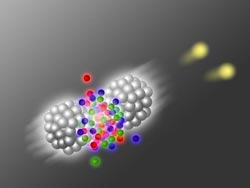CERN collider to become the world's fastest stopwatch?

Two lead atoms collide, creating a quark gluon plasma, which can emit ultra short laser pulses.<br><br>Credit: Vienna University of Technology<br>
Heavy ion collisions at CERN should be able to produce the shortest light pulses ever created. This was demonstrated by computer simulations at the Vienna University of Technology.
The pulses are so short that they cannot even be measured by today's technological equipment. Now, a method has been proposed to create the world's most precise stopwatch for the world's shortest light pulses, using a detector which is going to be installed at CERN in 2018.
Small, Short and Hot
Phenomena taking place on very short time scales are often investigated using ultra short laser pulses. Today, pulse durations of the order of attoseconds (billionths of a billionths of a second, 10^-18 seconds) can be created. But these records could soon be broken: “Atomic nuclei in particle colliders like the LHC at CERN or at RHIC can create light pulses which are still a million times shorter than that”, says Andreas Ipp from TU Vienna.
In the ALICE experiment at CERN, lead nuclei are collided almost at the speed of light. The debris of the scattered nuclei together with new particles created by the power of the impact form a quark-gluon plasma, a state of matter which is so hot that even protons and neutrons melt. Their building blocks – quarks and gluons – can move independently without being bound to each other. This quark-gluon plasma only exists for several yoctoseconds (10^-24 seconds).
Ideas From Astronomy
From the quark-gluon plasma created in a particle collider, light pulses can be emitted, which carry valuable information about the plasma. However, conventional measurement techniques are much too slow to resolve flashes on a yoctosecond timescale. “That's why we make use of the Hanbury Brown-Twiss effect, an idea which was originally developed for astronomical measurements”, says Andreas Ipp.
In a Hanbury Brown-Twiss experiment, correlations between two different light detectors are studied. That way, the diameter of a star can be calculated very precisely. “Instead of studying spatial distances, the effect can just as well be used for measuring time intervals”, says Andreas Ipp. The calculations he did together with Peter Somkuti show that the yoctosecond pulses of the quark-gluon plasma could be resolved by a Hanbury Brown-Twiss experiment. “It would be hard to do, but it would definitely be achievable”, says Ipp. This experiment would not require any additional expensive detectors, it could be done with the “forward calorimeter”, which is supposed to go on line at CERN in 2018. That way, the ALICE-experiment could become the world's most accurate stopwatch.
The Enigmas of the Plasma
There are still many open questions in quark-gluon plasma physics. It has an extraordinarily low viscosity, it is thinner than any liquid we know. Even if it starts out in a state of extreme disequilibrium, it reaches a thermal equilibrium extremely fast. Studying the light pulses from the quark-gluon plasma could yield valuable new information to better understand this state of matter.
In the future, the light pulses could perhaps even be used for nuclear research. “Experiments using two light pulses are often used in quantum physics”, says Andreas Ipp. “The first pulse changes the state of the object under investigation, a second pulse is used shortly after that, to measure the change.” With yoctosecond light pulses, this well-established approach could be used in areas which up until now have been completely inaccessible to this kind of research.
Further information:
Dr. Andreas Ipp
Institute for Theoretical Physics
Vienna University of Technology
Wiedner Hauptstr. 8-10, 1040 Vienna
T: +43 1 58801 13635
ipp@hep.itp.tuwien.ac.at
Media Contact
More Information:
http://www.tuwien.ac.atAll latest news from the category: Physics and Astronomy
This area deals with the fundamental laws and building blocks of nature and how they interact, the properties and the behavior of matter, and research into space and time and their structures.
innovations-report provides in-depth reports and articles on subjects such as astrophysics, laser technologies, nuclear, quantum, particle and solid-state physics, nanotechnologies, planetary research and findings (Mars, Venus) and developments related to the Hubble Telescope.
Newest articles

Silicon Carbide Innovation Alliance to drive industrial-scale semiconductor work
Known for its ability to withstand extreme environments and high voltages, silicon carbide (SiC) is a semiconducting material made up of silicon and carbon atoms arranged into crystals that is…

New SPECT/CT technique shows impressive biomarker identification
…offers increased access for prostate cancer patients. A novel SPECT/CT acquisition method can accurately detect radiopharmaceutical biodistribution in a convenient manner for prostate cancer patients, opening the door for more…

How 3D printers can give robots a soft touch
Soft skin coverings and touch sensors have emerged as a promising feature for robots that are both safer and more intuitive for human interaction, but they are expensive and difficult…





















